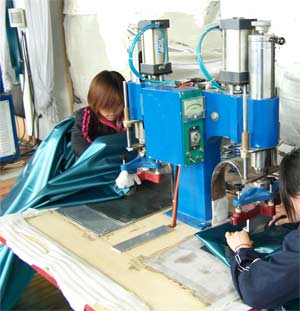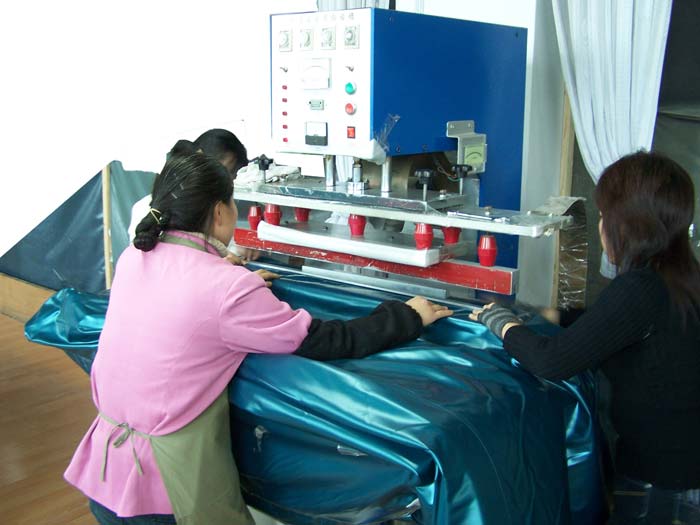
Waterbeds-
Manufacturers
We use for the manufacturing of our highest waterbed- quality the plasticizer Mesamoll® 2 produced by Bayer Chemicals and Lanxess, two divisions of the german Bayer AG. This makes the foils more durable, the welding- process easier and the weldings much more longlife. Hydrolysis-resistant plasticizer makes waterbed- manufacturing and the product waterbed more secure. Works away quietly to let you sleep soundly.
Many medical professionals and physiotherapists have long considered waterbeds to be an ideal natural solution for preventing sleep disorders or alleviating the pain associated with back problems. Yet the fact that these "wellness oases" in the bedroom are attracting ever more converts is also due to the PVC film from which water mattresses are made becoming ever more secure in recent years.
 The plasticizer
Mesamoll®, a safe
and, above all, durable alkyl sulfonic acid ester of phenol
with good gelation characteristics produced by Bayer Chemicals, a
division of Bayer AG, has played a major part in this development:
its
good migration resistance and high hydrolysis resistance
ensure that Quiaomenglai waterbeds remain comfortable
for many years and customers are spared the unnecessary emissions associated
with earlier
products.
The plasticizer
Mesamoll®, a safe
and, above all, durable alkyl sulfonic acid ester of phenol
with good gelation characteristics produced by Bayer Chemicals, a
division of Bayer AG, has played a major part in this development:
its
good migration resistance and high hydrolysis resistance
ensure that Quiaomenglai waterbeds remain comfortable
for many years and customers are spared the unnecessary emissions associated
with earlier
products.
It is above all the plasticizer in the PVC film that has a major role to play, working particularly hard undetected to ensure the sleeper can relax fully and at comfortable temperature in the waterbed. A number of plasticizers cannot withstand the rigors of life in a waterbed for long: they diffuse out of the film contaminating the room with odorous organic emissions, are washed out by water and act as nourishment for microorganisms. In extreme cases, all this means that not only does the waterbed film shrink in the course of time – by up to 10 percent - but it also loses its suppleness and finally turns brittle.
This is where the plasticizer Mesamoll® comes to the rescue. Its high saponification resistance means it is not hydrolyzed on contact with water and, even in adverse conditions, stays where it’s supposed to: in the film. This has been proven in outdoor weathering tests in the harsh climate of the North Sea and in Florida. While tensile strength and elongation at break were clearly reduced by up to 53 percent in some plasticized films after a few years, attributable to the plasticizer leaching out, the properties of the film containing Mesamoll® remained virtually constant at the original high level. So Quiaomenglai waterbeds can convince prospective purchasers with their long-lasting superior flexibility and tear resistance. While the quality of normal foam mattresses deteriorates with time so they have to be replaced, Quiaomenglai waterbeds should offer the same level of comfort for years – so that purchasing a waterbed soon pays for itself and not just for health reasons.
 Mesamoll® also
offers Quiaomenglai engineers distinct benefits
in waterbed production: high-frequency welding helps make the mattress
seams, which have proved to be weak points in a number of older products
over the years, secure and, what is more, keeps them very soft – contributing,
alongside a special liner system patented by a german customer of Quiaomenglai,
to the enhanced securency of the German waterbeds.
Mesamoll® also
offers Quiaomenglai engineers distinct benefits
in waterbed production: high-frequency welding helps make the mattress
seams, which have proved to be weak points in a number of older products
over the years, secure and, what is more, keeps them very soft – contributing,
alongside a special liner system patented by a german customer of Quiaomenglai,
to the enhanced securency of the German waterbeds.
Waterbeds
are obviously only one example where Mesamoll® proves
itself to be an efficient alternative. Its characteristics make
the additive the preferred plasticizer in a number of other areas.
Its excellent hydrolysis resistance, for example, has brought noticeable
benefits in coating
delicate fabrics in the manufacture of artificial leather.
Its excellent
hydrolysis resistance and compatibility with a number of polymers enables
products elastified with Mesamoll® to cut a good figure,
even in applications where there is frequent or permanent
contact with aggressive media: such as floor coverings frequently
treated with “harsh” cleaning
agents or in polyurethane jointing compounds and expansion
joint bonds which make contact with alkaline concrete.
Waterbeds
of Qiaomenglai manufactures many articles for the waterbed system.
One of the leading waterbed manufacturer worldwide. waterbed or watermattress
softside hardside. Producer of waterbed brands worldwide. Handmade
waterbeds by modern machines. High quality waterbeds.Waterbed factory.
